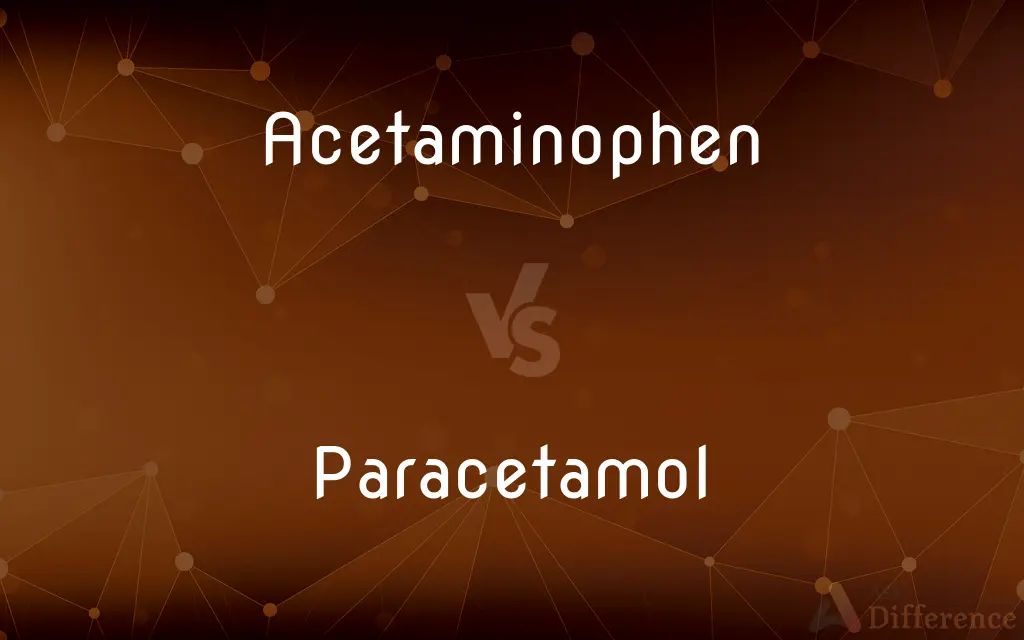Acetaminophen vs. Paracetamol — What's the Difference?
By Urooj Arif & Fiza Rafique — Updated on March 22, 2024
Acetaminophen and paracetamol refer to the same chemical compound, used as a pain reliever and fever reducer, with the primary difference being the name by which it is known in different countries.

Difference Between Acetaminophen and Paracetamol
Table of Contents
ADVERTISEMENT
Key Differences
Acetaminophen is the name commonly used in the United States, Japan, Canada, Venezuela, Colombia, and Iran for a widely used over-the-counter analgesic (pain reliever) and antipyretic (fever reducer). Paracetamol, on the other hand, is the name used for the same compound in most other parts of the world, including Europe, Australia, Brazil, South Africa, and India. Despite the difference in nomenclature, the compound referred to is the same: a non-opioid analgesic that helps relieve mild to moderate pain and reduce fever.
The distinction in naming arises from the compound's chemical name, N-acetyl-para-aminophenol, with "acetaminophen" derived from the chemical's systematic name and "paracetamol" derived from its chemical structure. Both names are acceptable and are used interchangeably in the scientific community, depending on the regional convention.
Acetaminophen/paracetamol is effective for various conditions such as headache, muscle aches, arthritis, backache, toothaches, colds, and fevers. It works by inhibiting the synthesis of chemical messengers called prostaglandins, which help to transmit pain signals and induce fever in the brain. It's available in various forms, including tablets, capsules, liquid suspensions, and as an ingredient in many cold and flu medications.
While acetaminophen/paracetamol is widely regarded as safe when taken at recommended doses, excessive intake can lead to severe liver damage and potentially fatal liver failure. Therefore, it's crucial for users to adhere to the dosage instructions and consult healthcare professionals if unsure about its use, especially when taken with other medications that may impact liver function.
The interchangeable use of "acetaminophen" and "paracetamol" reflects the global reach of this essential medication, emphasizing the importance of understanding local terminology, especially when traveling or consuming international medical literature and resources.
ADVERTISEMENT
Comparison Chart
Nomenclature
Used in the US, Japan, Canada, among others.
Commonly used in Europe, Australia, Brazil, and other regions.
Chemical Compound
N-acetyl-para-aminophenol
N-acetyl-para-aminophenol
Usage
Pain reliever and fever reducer.
Pain reliever and fever reducer.
Mechanism of Action
Inhibits prostaglandin synthesis.
Inhibits prostaglandin synthesis.
Safety
Safe at recommended doses, but excessive use can lead to liver damage.
Safe at recommended doses, but excessive use can lead to liver damage.
Compare with Definitions
Acetaminophen
Acetaminophen is an analgesic and antipyretic used primarily in North America.
She took acetaminophen to relieve her headache.
Paracetamol
It has the same applications as acetaminophen, for fever and mild pain.
Paracetamol is effective in treating mild arthritis pain.
Acetaminophen
It's known for its ability to reduce fever and relieve pain.
Acetaminophen is often recommended for fever in children.
Paracetamol
Paracetamol is the name used for acetaminophen in many countries outside North America.
Paracetamol is widely used in Europe for pain relief.
Acetaminophen
Commonly found in combination with other medications.
Many cold medicines contain acetaminophen for pain relief.
Paracetamol
Often present in flu and cold remedies.
This flu remedy's active ingredient is paracetamol for fever reduction.
Acetaminophen
Available over-the-counter in various formulations.
Acetaminophen can be found in both tablet and liquid form.
Paracetamol
Overdose can lead to acute liver failure.
Paracetamol overdose requires immediate medical attention due to the risk of liver failure.
Acetaminophen
Must be used cautiously to avoid liver damage.
He was cautioned not to exceed the daily limit of acetaminophen.
Paracetamol
Also available in several forms, including effervescent tablets.
She prefers the effervescent paracetamol for quicker absorption.
Acetaminophen
A crystalline compound, C8H9NO2, used in medicine to relieve pain and reduce fever. Also called paracetamol.
Paracetamol
Paracetamol, also known as acetaminophen, is a medication used to treat fever and mild to moderate pain. At a standard dose, paracetamol only slightly decreases body temperature; it is inferior to ibuprofen in that respect, and the benefits of its use for fever are unclear.
Acetaminophen
(North America) A white crystalline compound used in medicine as an anodyne to relieve pain and reduce fever.
Paracetamol
See acetaminophen.
Acetaminophen
A white crystalline compound (HO.C6H4.NH.CO.CH3) used as an analgesic and also as an antipyretic. It has molecular weight 151.16. It is the active ingredient in the commercial analgesics Tylenol and Datril.
Paracetamol
(pharmaceutical drug) a synthetic compound used as a drug to relieve and reduce fever, usually taken in tablet form
Acetaminophen
An analgesic for mild pain; also used as an antipyretic; (Datril and Tylenol and Panadol and Phenaphen and Tempra and Anacin III are trademarks of brands of acetaminophen tablets)
Common Curiosities
Why is it called acetaminophen in some countries and paracetamol in others?
The naming difference stems from the compound's chemical name, with each term reflecting different aspects of its chemical structure.
How does acetaminophen/paracetamol reduce fever?
It works by inhibiting the production of prostaglandins in the brain, which are substances that can cause fever.
Is there a difference between acetaminophen and paracetamol?
No, acetaminophen and paracetamol are two names for the same medication, differing only by regional nomenclature.
Can acetaminophen/paracetamol be taken with other medications?
While it can be combined with some medications, it's important to avoid exceeding the recommended daily dose and to consult a healthcare provider when taken with other drugs, especially those affecting the liver.
Is acetaminophen/paracetamol safe for children?
Yes, when used at age-appropriate doses, it is considered safe for children, but it's essential to follow dosing instructions carefully.
Can acetaminophen/paracetamol be used for severe pain?
It is primarily effective for mild to moderate pain; severe pain may require alternative or additional medications.
What are the risks of taking too much acetaminophen/paracetamol?
Excessive intake can lead to serious liver damage and potentially fatal liver failure.
How should acetaminophen/paracetamol be stored?
It should be stored at room temperature, away from moisture and heat, and out of reach of children.
How quickly does acetaminophen/paracetamol take effect?
It typically starts to relieve pain and reduce fever within 30 minutes to an hour after ingestion, depending on the formulation and individual metabolism.
Share Your Discovery

Previous Comparison
Audacious vs. Audacity
Next Comparison
Segmental vs. SuprasegmentalAuthor Spotlight
Written by
Urooj ArifUrooj is a skilled content writer at Ask Difference, known for her exceptional ability to simplify complex topics into engaging and informative content. With a passion for research and a flair for clear, concise writing, she consistently delivers articles that resonate with our diverse audience.
Co-written by
Fiza RafiqueFiza Rafique is a skilled content writer at AskDifference.com, where she meticulously refines and enhances written pieces. Drawing from her vast editorial expertise, Fiza ensures clarity, accuracy, and precision in every article. Passionate about language, she continually seeks to elevate the quality of content for readers worldwide.














































